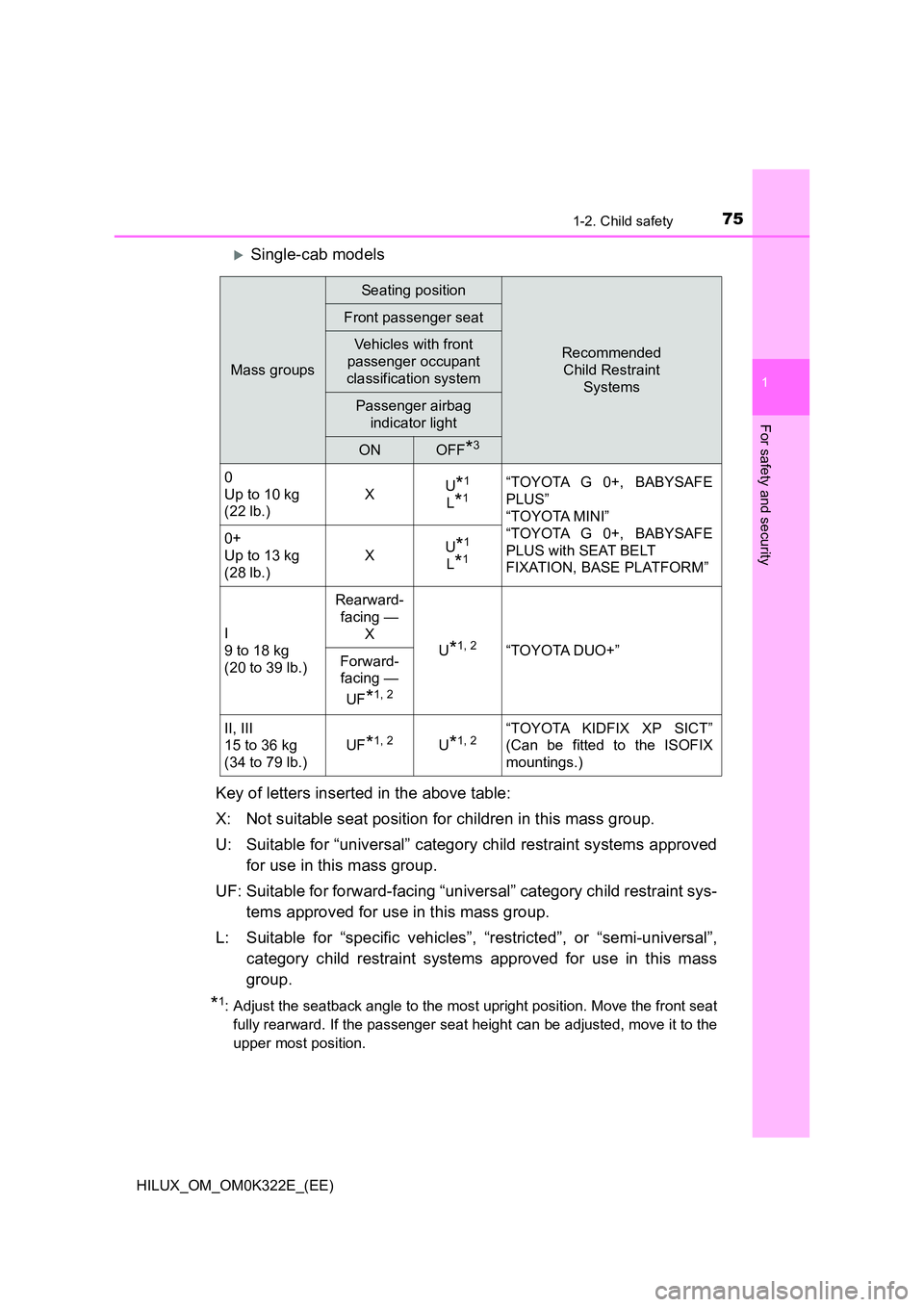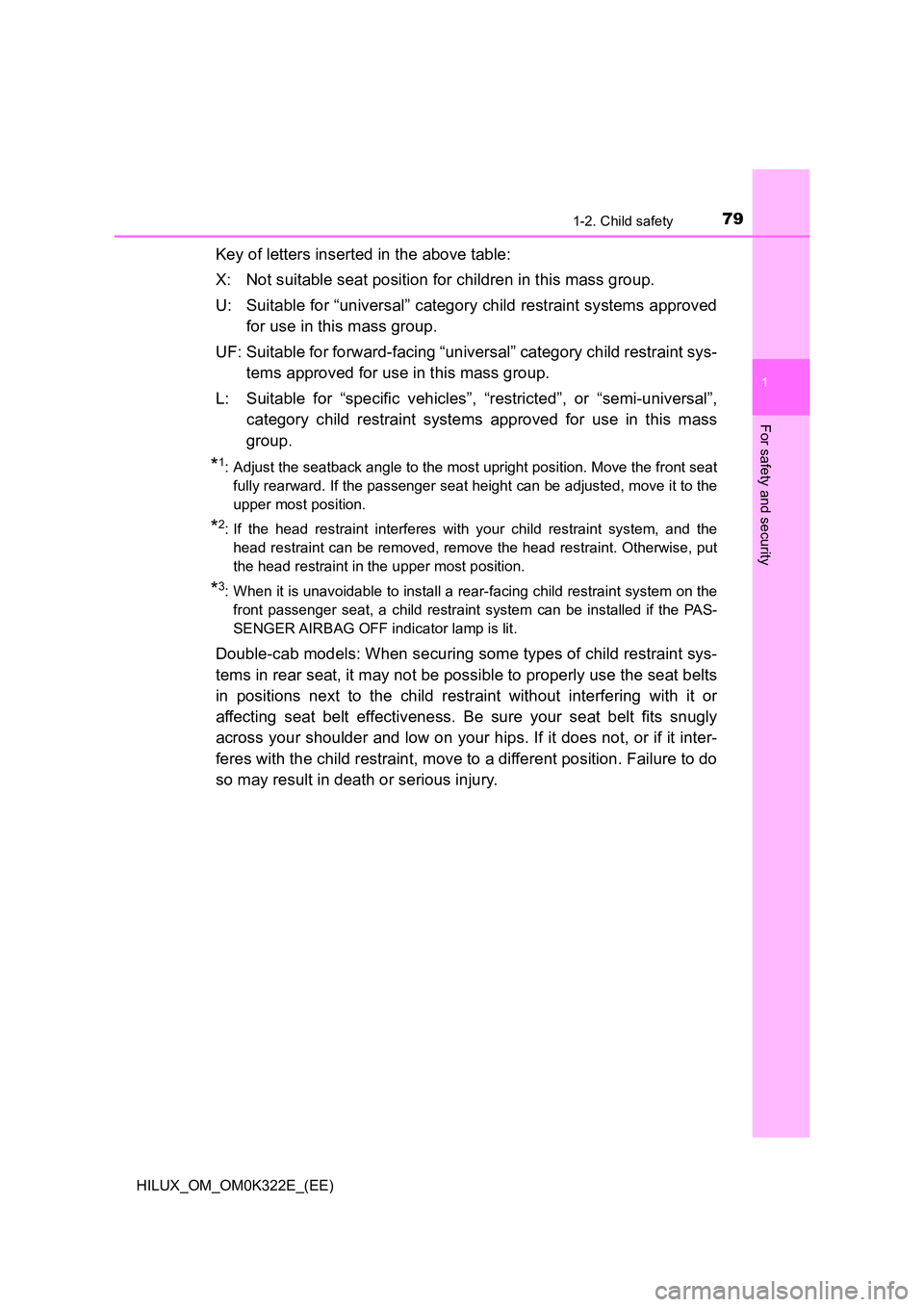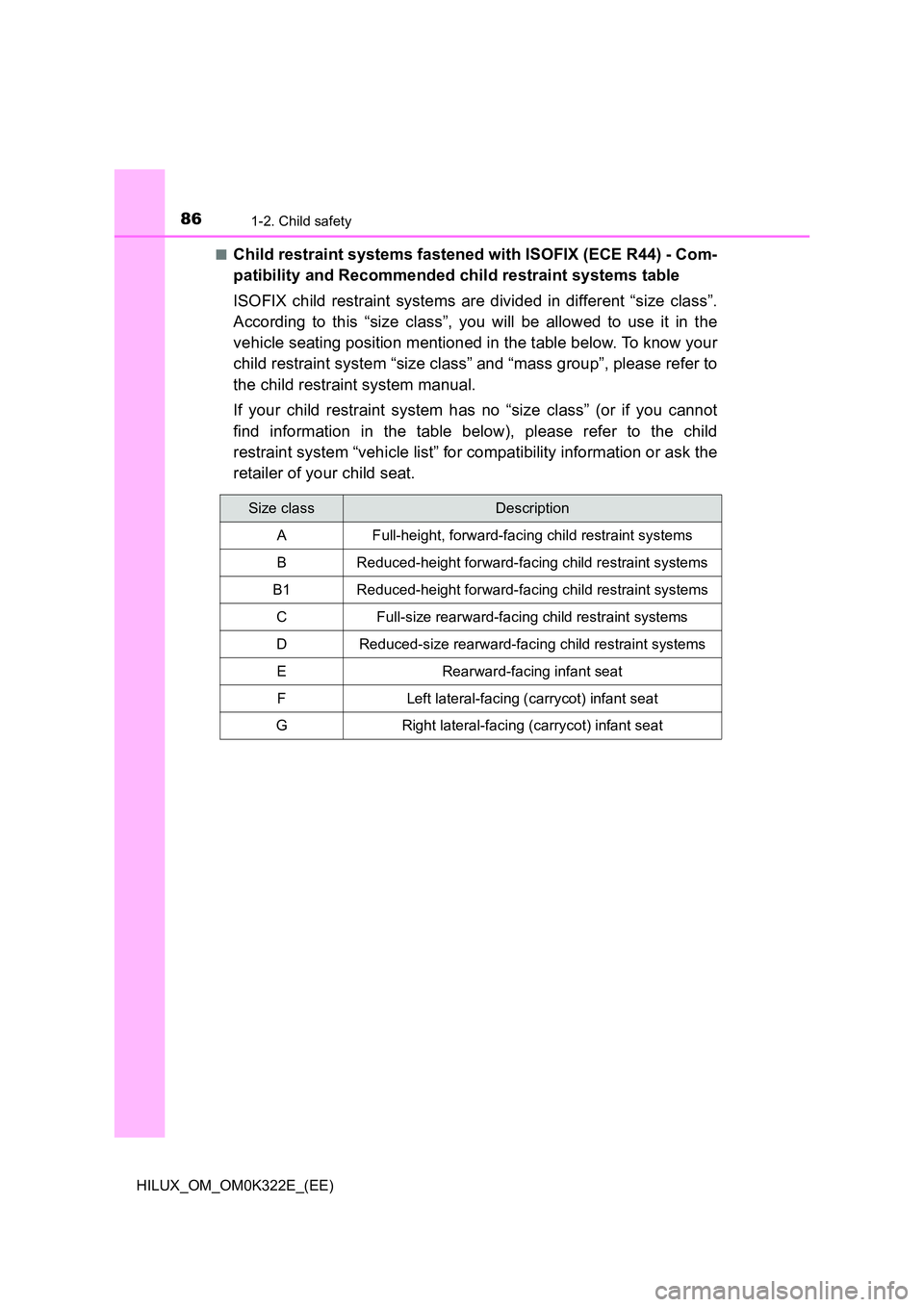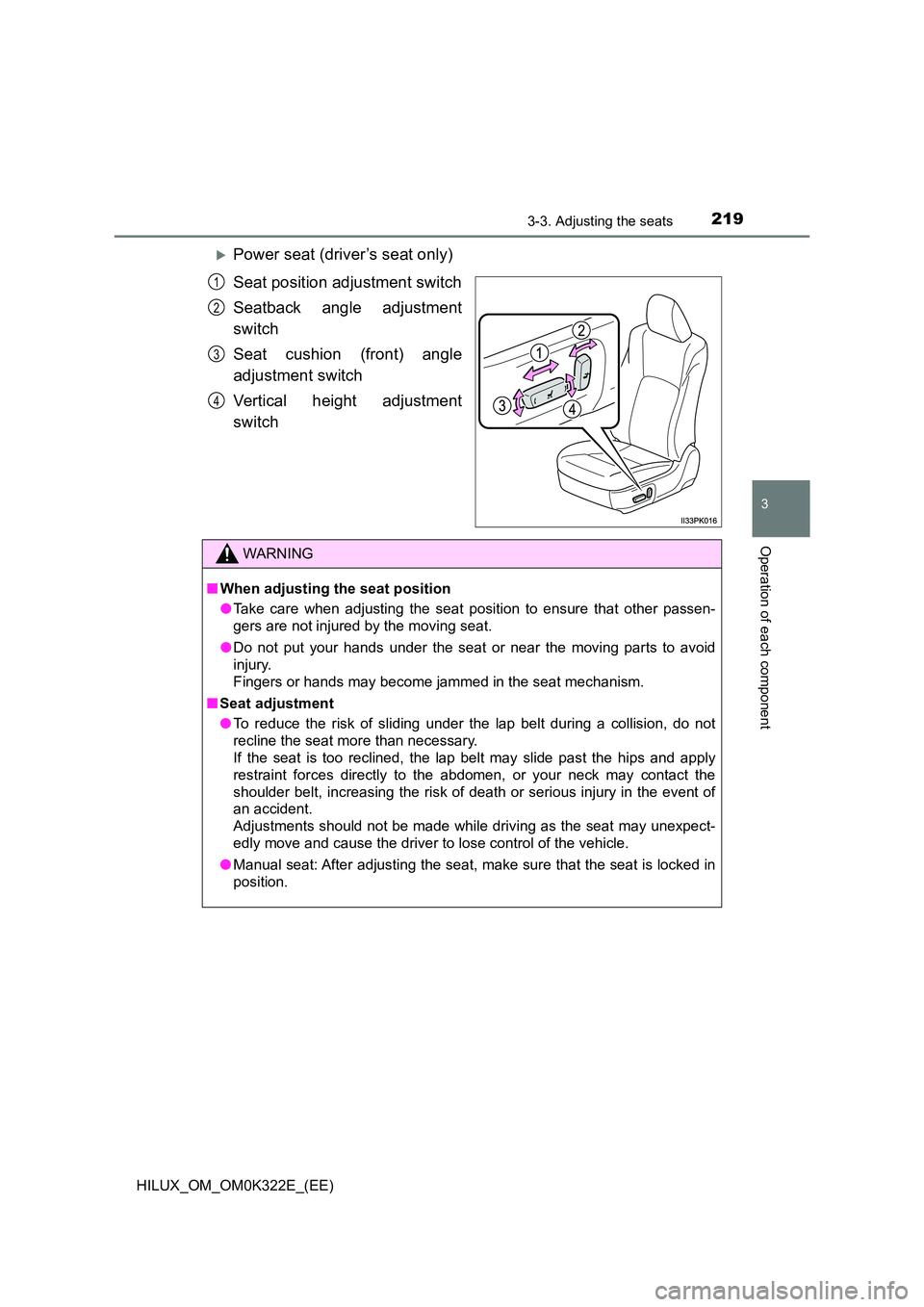Page 41 of 720
411-1. For safe use
1
HILUX_OM_OM0K322E_(EE)
For safety and security
To fasten the seat belt, push the
plate into the buckle until a click
sound is heard.
To release the seat belt, press
the release button.
Push the seat belt shoulder
anchor down while pulling the
lock release knob.
Push the seat belt shoulder
anchor up.
Move the height adjuster up and
down as needed until you hear a
click.
Lengthen
Shorten
Fastening and releasing the seat belt
Release button
1
2
Adjusting the seat belt shoulder anchor height (if equipped for
front seats)
1
2
Adjusting the length of the belt (2-point type seat belt) (if
equipped)
1
2
Page 68 of 720
681-2. Child safety
HILUX_OM_OM0K322E_(EE)
Install the available child restraint system in vehicle upon confirming
the following items.
■Standards for child restraint systems
Use a child restraint system that conforms to ECE R44*1 or
ECE R129*1, 2.
The following approval mark is displayed on child restraint systems
which are conformed.
Check for an approval mark attached to the child restraint system.
Example of the displayed regu-
lation number
ECE R44 approval mark*3
The weight range of the child
who is applicable for an
ECE R44 approval mark is
indicated.
ECE R129 approval mark*3
The height range of the child
who is applicable as well as
available weights for an
ECE R129 approval mark is
indicated.
*1: ECE R44 and ECE R129 are U.N. regulations for child restraint sys-
tems.
*2: The child restraint systems mentioned in the table may not be available
outside of the EU area.
*3: The displayed mark may differ depending on the product.
Child restraint system
1
2
Page 75 of 720

751-2. Child safety
1
HILUX_OM_OM0K322E_(EE)
For safety and security
Single-cab models
Key of letters inserted in the above table:
X: Not suitable seat position for children in this mass group.
U: Suitable for “universal” category child restraint systems approved
for use in this mass group.
UF: Suitable for forward-facing “universal” category child restraint sys-
tems approved for use in this mass group.
L: Suitable for “specific vehicles”, “restricted”, or “semi-universal”,
category child restraint systems approved for use in this mass
group.
*1: Adjust the seatback angle to the most upright position. Move the front seat
fully rearward. If the passenger seat height can be adjusted, move it to the
upper most position.
Mass groups
Seating position
Recommended
Child Restraint
Systems
Front passenger seat
Vehicles with front
passenger occupant
classification system
Passenger airbag
indicator light
ONOFF*3
0
Up to 10 kg
(22 lb.)
X U*1
L*1“TOYOTA G 0+, BABYSAFE
PLUS”
“TOYOTA MINI”
“TOYOTA G 0+, BABYSAFE
PLUS with SEAT BELT
FIXATION, BASE PLATFORM”
0+
Up to 13 kg
(28 lb.)
X U*1
L*1
I
9 to 18 kg
(20 to 39 lb.)
Rearward-
facing —
X
U*1, 2“TOYOTA DUO+” Forward-
facing —
UF*1, 2
II, III
15 to 36 kg
(34 to 79 lb.)
UF*1, 2U*1, 2“TOYOTA KIDFIX XP SICT”
(Can be fitted to the ISOFIX
mountings.)
Page 77 of 720
771-2. Child safety
1
HILUX_OM_OM0K322E_(EE)
For safety and security
UF: Suitable for forward-facing “universal” category child restraint sys-
tems approved for use in this mass group.
L: Suitable for “specific vehicles”, “restricted”, or “semi-universal”,
category child restraint systems approved for use in this mass
group.
*1: Adjust the seatback angle to the most upright position. Move the front seat
fully rearward. If the passenger seat height can be adjusted, move it to the
upper most position.
*2: If the head restraint interferes with your child restraint system, and the
head restraint can be removed, remove the head restraint. Otherwise, put
the head restraint in the upper most position.
*3: When it is unavoidable to install a rear-facing child restraint system on the
front passenger seat, a child restraint system can be installed if the PAS-
SENGER AIRBAG OFF indicator lamp is lit.
Page 79 of 720

791-2. Child safety
1
HILUX_OM_OM0K322E_(EE)
For safety and security
Key of letters inserted in the above table:
X: Not suitable seat position for children in this mass group.
U: Suitable for “universal” category child restraint systems approved
for use in this mass group.
UF: Suitable for forward-facing “universal” category child restraint sys-
tems approved for use in this mass group.
L: Suitable for “specific vehicles”, “restricted”, or “semi-universal”,
category child restraint systems approved for use in this mass
group.
*1: Adjust the seatback angle to the most upright position. Move the front seat
fully rearward. If the passenger seat height can be adjusted, move it to the
upper most position.
*2: If the head restraint interferes with your child restraint system, and the
head restraint can be removed, remove the head restraint. Otherwise, put
the head restraint in the upper most position.
*3: When it is unavoidable to install a rear-facing child restraint system on the
front passenger seat, a child restraint system can be installed if the PAS-
SENGER AIRBAG OFF indicator lamp is lit.
Double-cab models: When securing some types of child restraint sys-
tems in rear seat, it may not be possible to properly use the seat belts
in positions next to the child restraint without interfering with it or
affecting seat belt effectiveness. Be sure your seat belt fits snugly
across your shoulder and low on your hips. If it does not, or if it inter-
feres with the child restraint, move to a different position. Failure to do
so may result in death or serious injury.
Page 86 of 720

861-2. Child safety
HILUX_OM_OM0K322E_(EE)
■Child restraint systems fastened with ISOFIX (ECE R44) - Com-
patibility and Recommended child restraint systems table
ISOFIX child restraint systems are divided in different “size class”.
According to this “size class”, you will be allowed to use it in the
vehicle seating position mentioned in the table below. To know your
child restraint system “size class” and “mass group”, please refer to
the child restraint system manual.
If your child restraint system has no “size class” (or if you cannot
find information in the table below), please refer to the child
restraint system “vehicle list” for compatibility information or ask the
retailer of your child seat.
Size classDescription
A Full-height, forward-facing child restraint systems
B Reduced-height forward-facing child restraint systems
B1 Reduced-height forward-facing child restraint systems
C Full-size rearward-facing child restraint systems
D Reduced-size rearward-facing child restraint systems
E Rearward-facing infant seat
F Left lateral-facing (carrycot) infant seat
G Right lateral-facing (carrycot) infant seat
Page 218 of 720
2183-3. Adjusting the seats
HILUX_OM_OM0K322E_(EE)
Front seats
Manual seat (separated type)
Seat position adjustment lever
Seatback angle adjustment
lever
Vertical height adjustment lever
(if equipped for driver’s seat
only)
Manual seat (bench type)
Seat position adjustment lever
(driver’s seat only)
Seatback angle adjustment
lever
Adjustment procedure
1
2
3
1
2
Page 219 of 720

2193-3. Adjusting the seats
3
Operation of each component
HILUX_OM_OM0K322E_(EE)
Power seat (driver’s seat only)
Seat position adjustment switch
Seatback angle adjustment
switch
Seat cushion (front) angle
adjustment switch
Vertical height adjustment
switch
1
2
3
4
WARNING
■ When adjusting the seat position
● Take care when adjusting the seat position to ensure that other passen-
gers are not injured by the moving seat.
● Do not put your hands under the seat or near the moving parts to avoid
injury.
Fingers or hands may become jammed in the seat mechanism.
■ Seat adjustment
● To reduce the risk of sliding under the lap belt during a collision, do not
recline the seat more than necessary.
If the seat is too reclined, the lap belt may slide past the hips and apply
restraint forces directly to the abdomen, or your neck may contact the
shoulder belt, increasing the risk of death or serious injury in the event of
an accident.
Adjustments should not be made while driving as the seat may unexpect-
edly move and cause the driver to lose control of the vehicle.
● Manual seat: After adjusting the seat, make sure that the seat is locked in
position.